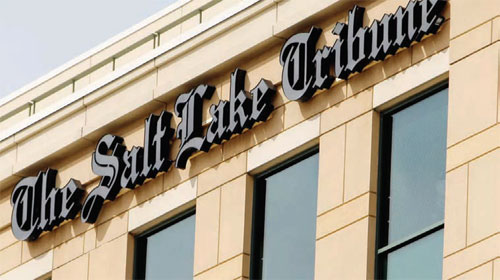By Brice Wallace
If The Salt Lake Tribune’s move to becoming a nonprofit organization works, readers will likely see a larger reporting staff, an editorial page that “will change slightly” and a newspaper that “will remain the independent voice,” according to the newspaper’s editor.{mprestriction ids="1,3"}
Speaking in Salt Lake City last week, Jennifer Napier-Pearce also said the switch to a nonprofit model also will mean Paul Huntsman, who acquired the newspaper in 2016, will no longer be the newspaper’s sole owner as he turns it over to the community.
The Tribune recently received approval from the IRS to become a nonprofit, making it the first “legacy” newspaper in the U.S. to do so. While newspapers in Philadelphia and the Tampa Bay area are owned by nonprofits, those still-struggling newspapers remain for-profit entities. The Tribune’s action stemmed from Huntsman’s realization that newspaper was in dire straits and needed to change.
“Paul and I were just like, we’ve got to figure out something that will work in the long term,” Napier-Pearce said at a Salt Lake Rotary luncheon last week. “You know, if we create this endowment, it can get us by for a little while, but the newspaper itself is a community asset, right? Our mission is to serve the public. Our mission is very much in line with any other nonprofit organization in America. It is to do the public good. And so, we thought, you know, we’ve got to try this.”
The move occurs as newspaper print circulation and print advertising revenue across the nation are down. While digital advertising is a growing share of newspaper ad revenue, lots of digital advertising has been siphoned to Google and Facebook. As a result, staff layoffs have become commonplace — the Tribune reported that it has 60 on its staff, down from 148 in 2011 — and 2,000 U.S. newspapers have shut down since 2004.
The nonprofit model allows the Tribune to add philanthropy to the existing revenue sources of advertising and circulation. The Utah Journalism Foundation is creating an endowment to fund independent journalism in Utah, including the Tribune, and The Salt Lake Tribune Inc. has been formed to benefit the newsroom, projects and community engagement.
While the Tribune expected some “back-and-forth” negotiating with the IRS after it applied for nonprofit status this spring, that never transpired. IRS approval, which was expected next spring, came instead in a letter dated Oct. 29 and without reservation, Napier-Pearce said.
Among the changes readers will see is that the Tribune will no longer be able to endorse political candidates, although it will continue to editorialize about issues. Huntsman will transfer his ownership to a public board of directors. A firewall will exist between the board and the newsroom, much in the way that a wall exists between advertisers and the newsroom, she said. “Our newsroom, I’m very, very confident, will remain the independent voice,” she said.
Napier-Pearce acknowledged that the print side of the Tribune remains “just a big question mark” because a business relationship with the Deseret News, called a joint operating agreement, in place since the 1950s expires at the end of 2020. The Tribune contracts with the Deseret News for printing services. A third business, MediaOne, is 40-percent owned by the Tribune and 60-percent owned by the Deseret News, and handles other functions for both newspapers.
“I don’t know how all of this is going to shake out,” Napier-Pearce said of the print side. “We’ll see. And some of it is beyond our control. The economics of the newspaper industry itself will steer us as we make these decisions. But our contractual relationship? I don’t know how that’s going to work. We’ll see.”
As for the Tribune newsroom, she said the plan is to increase staff.
“That is where you all come in,” she told the Rotary Club audience. “I want to rebuild our newsroom. Last year was absolutely devastating, to let a third our newsroom go. It was horrible. I’m never going to do it again. I will quit before asking that again. But the fact is that this community needs the kind of journalism that the Tribune can provide,” she said.
Supporters can now make tax-deductible donations. The Tribune hopes to raise $60 million during the next three years and $150 million in 15 years for the Utah Journalism Foundation, to help the Tribune and other local newspapers.
In a piece about the move to nonprofit status, Huntsman, also the newspaper’s publisher, said the Tribune “is too important to shutter as hundreds of publications across the country have over the past decade.” He also said that “now we all have the chance to revitalize the state’s independent voice in a new and permanent way.”
Napier-Pearce called the fundraising goals “ambitious” but “realistic.”
“And that fund is not just going to benefit the Tribune, but it’s also going to benefit independent journalism throughout the state of Utah,” she said, noting that newspapers in Utah are struggling and those in Ogden and Provo have seen ownership changes.
“There’s a lot of journalism but it’s shrinking,” she said. “We know that citizens need that, so this endowment fund of course is going to benefit us, but we anticipate that it will benefit other local journalism, too. Between the two — the Tribune nonprofit and the Utah Journalism Foundation — we think we’ve created a sustainable piece.”
Napier-Pearce listed several reasons why she believes the move to a nonprofit will work for the Tribune. Among them are the newspaper’s reputation as a trusted news source and its award-winning coverage, the fact that Huntsman has been involved in nonprofits, and Utah’s entrepreneurial spirit.
“We have full confidence in Utahns just ‘getting it,’” she said. “We’re pioneers, right? We know how to get things done in new and different ways. We love innovation, and this is what innovation is.”{/mprestriction}








